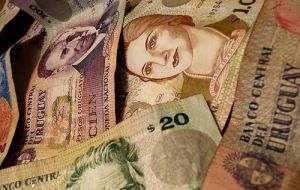MercoPress. South Atlantic News Agency
Uruguayan Peso over-valued 17.4% against the dollar according to Big Mac’s PPP
 The Big Mac indicates the US dollar should be trading at 21.62 Pesos
The Big Mac indicates the US dollar should be trading at 21.62 Pesos The Uruguayan Peso is 17.4% over-valued against the US dollar according to the Big Mac index from The Economist which means the greenback should be trading in Montevideo money markets at 21.62 Pesos and not 18.25 Pesos as currently happens.
Mercosur partners Argentina and Brazil are undergoing a similar situation as US excess liquidity floods world markets with dollars that force the appreciation of local currencies, a phenomenon Brazil officially identifies as the “currencies war”.
The reference for such statement is McDonald’s famous Big Mac and its Purchasing Power Parity, PPP, which in the US costs 4.07 dollars and has been compared to prices in the region on July 25, according to a report published in the Montevideo press.
Even when Big Mac is having a winter-holiday promotion in Uruguay and selling at 60 Uruguayan pesos, its normal price is 88 pesos, which works out at 4.78 dollars.
The report indicates Uruguay is thus in a similar situation to 14 of the 36 countries to which The Economist applies the Big Mac index as a reliable comparable index.
Basically the Uruguayan peso is 17.4% over-valued which means the US dollar in the foreign exchange market should be selling at 21.62 Pesos. If this was the case and based on the PPP, buying a Big Mac in Uruguay would cost the same as in the US.
The previous report was from October 2010, when the over-value was calculated at 13.2%. At the time the US dollar was trading locally at 20.22 pesos and according to Big Mac’s PPP should have been at 22.64 pesos to the dollar.
So far this year the Uruguayan peso has appreciated 8.38%.
But the phenomenon is not limited to Uruguay, in Brazil the Super Real, as it is called now, has appreciated even more. For example the price of a Big Mac in Brazil is the equivalent of 6.16 dollars which means the local currency is 51.4% above its equilibrium value.
In other words the dollar/Real exchange rate should be 2.34 when in reality last Friday markets were trading at 1.55 Real to the greenback.
In Argentina the situation is more similar to that of Uruguay with the Argentine Peso overvalued in 18.9%. The price of a Big Mac is 4.84 dollars in Argentina, which means the exchange rate should be established at 4.92 Argentine pesos to the dollar, when it really stands at 4.13 pesos.
But if GDP per capita is taken into account, the exchange rate misbalance is even greater. This is because in emerging countries the Big Mac should be cheaper since labour overall is less qualified and should have a per unit cost lower than in industrialized countries.
This means that the difference in exchange rate for Brazil soars to 149% and in Argentina to 101%. However this is not the case for Uruguay.
But in some Latin American countries the opposite is also true with some currencies under-valued according to GDP per capita PPP. This would be the cases of countries as Mexico (-32%); Peru (-10.3%) and Chile (-1.7%). In Asia there are also extreme cases such as China (-44.2%) and Hong Kong (-52.3%).




Top Comments
Disclaimer & comment rulesCommenting for this story is now closed.
If you have a Facebook account, become a fan and comment on our Facebook Page!